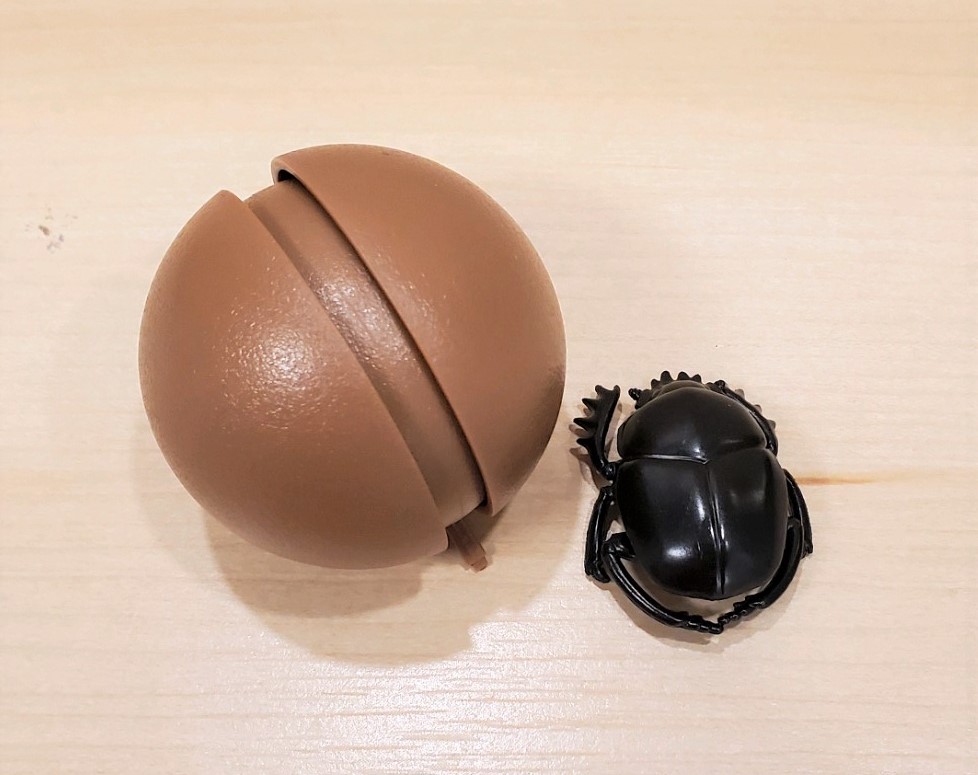Yes, that is the name of the collection…
The Great Pyramids of Egypt. What was their grand purpose and influence? Merely grandeur tombs for Egyptian royalty? Conduits for alien visitors? A regeneration site for En Sabah Nur? Or maybe they are just giant piles of cow sh*t! Yes, really! Ever notice how a pyramid is shaped like a cascading pile of cow dung? What is under the pyramids? The burial chamber of pharoahs. And what’s under a pile of dung? The pupal chamber of scarab beetles! Also, ever notice that a mummy, delicately wrapped in white cloth with its arms folded over its chest, is very similar to the developing pupa of a scarab beetle?! The mummy in the burial chamber represents transition from life to the after life, just as the pupa of a beetle represents the transition from the larval to adult stage. There are just too many similarities to ignore. It’s well known the ancient Egyptians revered dung-rolling scarabs, as it is also believed that the scarab rolling the ball of dung over the dunes represents Khepri, the god of the rising sun that rolled the sun through the underworld at night and over the horizon in the morning. Yes, with all the fascination of the ‘true’ significance of the pyramids, in the end they may have just represented giant stylized cow pies! Now, there are some biological inconsistencies that the pedantics are sure to pick up on. Namely, the pupal chambers under the dung piles are not of the same species as the dung-rollers, as the former are ‘tunnelers’ (usually members of the tribe Coprini) that create their brood chambers below or in close proximity to the dung piles whereas the latter (‘rollers’, usually members of the tribes Scarabaeini and Canthonini) roll their dung away to a secure location. That being said, the ancient Egyptians were not systematic entomologists and probably wouldn’t have noticed or cared about such differences; they would have just generally associated scarab beetles with dung.

Today we will be looking at a fairly recent (December 2021) release of a dung-rolling beetle by Kitan Club. It was one of five in a set, each with a different paint scheme. I picked the black beetle with the brown dung ball as it was probably the most realistic of the five, with the others having either the beetle, dung ball, or both painted to represent unnatural colors. The beetle was not identified at the species level but most-certainly represents a member of the genus Scarabaeus. The sacred scarab, S. sacer, is a logical choice; however the only species to made to date and identified at the species level (that I am aware of) is S. typhon, which was made by Epoch in 2004 and Kaiyodo in 2005. The figure is too simple to use morphology to identify it further, so I’ll simply tag it at the genus level for the Blog.

The beetle and the dung ball come as separate pieces (and honestly, the beetle by itself is a nice figure!). The beetle measures 3.5 cm, which does put it in scale for some species of Scarabaeus, including S. sacer.

A peg on the dung ball inserts into a hole on the underside of the beetle. It should be pressed in firmly, and it feels like there is some soft resistance, as if there is something gummy in the beetle to help secure the peg(?).

After the beetle is attached, the beetle is used as a ‘handle’ to ‘wind up’ the dung ball. Place it on a smooth surface and the dung ball rolls away, pulling the beetle figure with it. Unfortunately, I don’t have video capability to demonstrate it, but it works effectively.

Overall, this is an ingenious novelty toy, but it’s probably not something likely to be pursued by most of the regulars on the forums and blog (it could be fun and entertaining for children, if you have any!). However, if you want a decent figure of Scarabaeus, consider the figure from this toy. The aforementioned Scarabaeus figures by Epoch and Kaiyodo are long retired and possibly hard to get (the Epoch figure is especially difficult to come by).

Disclaimer: links to Ebay and Amazon on the AnimalToyBlog are affiliate links, so we make a small commission if you use them. Thanks for supporting us!




This is certainly one of the more unique toys on the blog. I never would have thought that a wind-up dung ball and beetle would be a thing. Also, I’ve never heard that pyramid theory before, that’s really quite interesting.
is this still available for purchase?